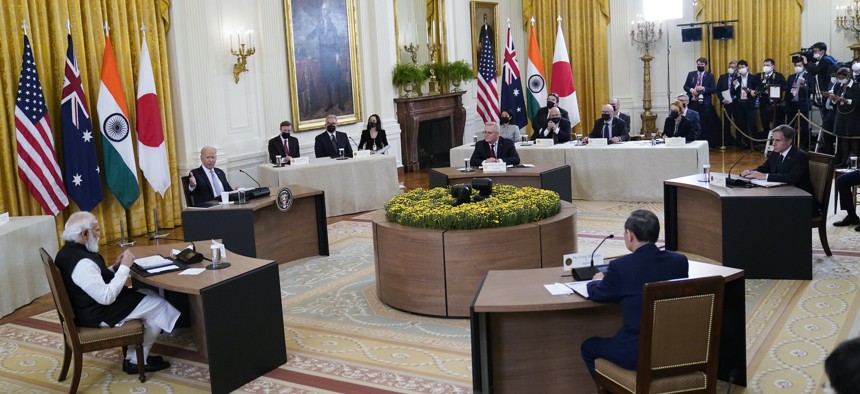
President Joe Biden speaks during the Quad summit with Australian Prime Minister Scott Morrison, Indian Prime Minister Narendra Modi, and Japanese Prime Minister Yoshihide Suga, in the East Room of the White House, Friday, Sept. 24, 2021, in Washington. AP / Evan Vucci
What’s Next for the Quad?
This year’s summit has demonstrated the leaders’ ambitions. Regular leaders’ summits will be needed to maintain the pace and focus.
For the first time, the leaders of the four countries that make up the Quad—the United States, Australia, India, and Japan—met together in person. Their September meeting at the White House solidified the group’s commitment to collaborating on a range of issues, including COVID-19 vaccines, climate change, and security in the Indo-Pacific. Now comes the difficult task of following through.
What is the most important takeaway from the Quad summit?
The most important takeaway is that all four leaders pledged to coordinate their strategic goals for the long-term benefit of their nations. Clearly, U.S. President Joe Biden, Australian Prime Minister Scott Morrison, Indian Prime Minister Narendra Modi, and Japanese Prime Minister Yoshihide Suga see their countries’ futures as intertwined and believe they are stronger together.
What challenges could the Quad face in following through on its commitments?
The leaders committed to donating 1.2 billion COVID-19 doses globally, forming a green-shipping network, establishing a semiconductor supply-chain initiative, and creating a working group on space, among other measures.
This is an ambitious agenda and implementing it will require deliberate and consistent attention. Coordinating policy across four nations and realizing the leaders’ goals call for innovative mechanisms. Existing mechanisms for collaboration will need to be built upon.
For example, the Quad’s vaccination goals will likely be implemented through the global initiative known as COVAX, as well as through bilateral channels. Supply-chain resilience will require private-sector coordination, as well as cross-national coordination.
The Quad leaders recognize the institutional changes they need to initiate now to realize the long-term capability to work together. One innovation announced at this summit was the Quad Fellowship led by the philanthropic initiative Schmidt Futures that will bring talent from all four countries together to work on leading-edge technologies.
Were there any new signals about the defense side of the partnership?
The Quad leaders have emphasized the broader economic and technological, rather than defensive, dimensions of strategy. This reflects the strengths of the Quad countries as well as concerns about growing economic competition with China. China’s willingness to use its economic leverage for strategic gain has persuaded the Quad leaders that they need to build more resilient and innovative economies that are not vulnerable to Beijing’s pressure.
The countries have pursued defensive partnerships outside of the Quad, including through the new AUKUS deal. But clearly, there is overlap in what analysts think of as the new domains of strategic competition where technological capabilities matter: cyber, space, and maritime awareness.
What’s next?
This year’s summit has demonstrated the leaders’ ambitions. Regular leaders’ summits will be needed to maintain the pace and focus. Fulfilling the Quad’s agenda will take effort, and institutionalizing these forums will take time.
In addition, future leaders of the United States, Australia, India, and Japan—all four are democracies with regular elections—will need to perceive the Quad as valuable. To build its momentum, the Quad will have to produce results while the current four leaders are in charge. The first new face to appear at the next Quad summit will be a different Japanese prime minister, Fumio Kishida, who takes charge next week.
This piece, first published by the Council on Foreign Relations, is used with permission.
NEXT STORY: America Should Help Iran Get COVID Vaccines



